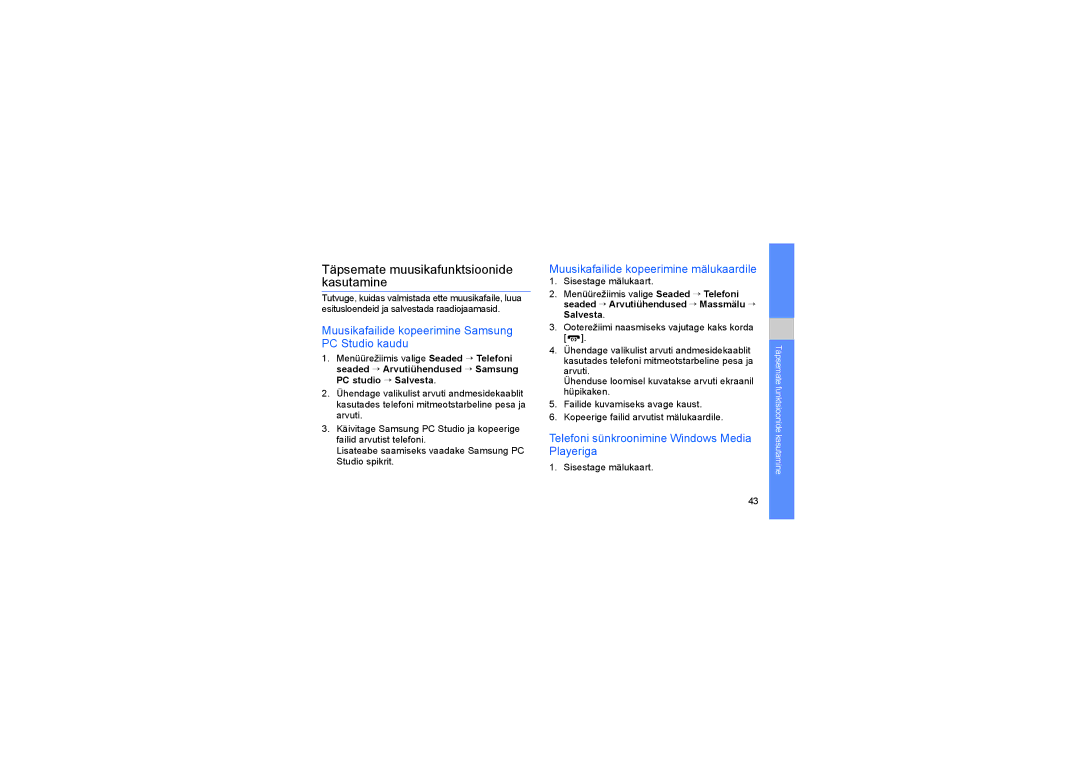Kasutusjuhend
Juhendavad ikoonid
Juhendi kasutamine
Näiteks
Teave autoriõiguse kohta
Väljumise klahvi
Iii
Sisukord
Põhiliste funktsioonide kasutamine
Tõrkeotsing
Kuulmise kaitsmine
Ohutusnõuded
Olge mobiilseadmete ja -varustuse paigaldamisel ettevaatlik
Vältige südamestimulaatorite häirimist
Vähendage korduva kokkupuute tekkimisel tekitatavat kahju
Ohutusabinõud
Liiklusohutus eelkõige
Järgige kõiki ohutusnõudeid ja -eeskirju
Käsitsege telefoni ettevaatlikult ja mõistlikult
Kaitske akusid ja laadijaid kahjustuste eest
Vältige teiste elektroonikaseadmete häirimist
Kasutage telefoni normaalasendis
Oluline kasutusteave
Käsitsege SIM- ja mälukaarte ettevaatlikult
Spetsiifilise neeldumismäära SAR sertimisteave
Tagage juurdepääs hädaabiteenustele
Õige viis toote kasutuselt kõrvaldamiseks
Lahtiütlus
Õige viis toote akude kasutusest kõrvaldamiseks
Ohutus- ja kasutusteave
Lahtipakkimine
Mobiiltelefoni tutvustus
Telefoni kujundus
Ekraan
Klahvid ja nupud
Teie telefoni ekraanil on järgmised piirkonnad
Tutvuge ekraanil kuvatavate ikoonidega
Ikoonid
Ikoon Tähendus
SIM-kaardi ja aku paigaldamiseks Eemaldage aku kaas
SIM-kaardi ja aku paigaldamine
Paigaldage aku Paigaldage aku kaas tagasi
Paigaldage SIM-kaart
Teave tühja aku indikaatori kohta
Aku laadimine
Mälukaardi paigaldamine valikuline
Ühenduseta profiili aktiveerimine
Telefoni sisse- ja väljalülitamine
Puuteekraani kasutamine
Vidinate kasutamine
Juurdepääs menüüdele
Vidina tööriistariba avamine
Vidinate lisamine ooteekraanile
Telefoni kohandamine
Abiteabe vaatamine
Klahvitoonide helitugevuse reguleerimine
Puuteekraani värina intensiivsuse reguleerimine
Helina muutmine
Vaikse profiili aktiveerimine ja desaktiveerimine
Taustpildi valimine ooterežiimi
Telefoni lukustamine
Helistamine
Põhiliste kõnefunktsioonide kasutamine
Kõnele vastamine
Helitugevuse reguleerimine
Peakomplekti kasutamine
Sõnumite saatmine ja vaatamine
Tekst- või multimeediumsõnumi saatmine
Kirja saatmine
Tekstisisestusrežiimi muutmine
Teksti sisestamine
Teksti sisestamine käsitsi kirjutamise kasti 1 kasutades
Muutke tekstisisestusrežiimiks Täisekraan
Teksti sisestamine käsitsi kirjutamise kasti 2 kasutades
Kirja vaatamine
Kontaktide lisamine ja otsimine
Uue kontakti lisamine
Kontakti otsimine
Pildistamine
Põhiliste kaamerafunktsioonide kasutamine
Fotode vaatamine
Pärast pildistamist valige , et vaadata fotosid kiiresti
Videoklipi salvestamine
Muusika kuulamine
Videoklipi vaatamine
FM-raadio kuulamine
FM-raadio juhtimiseks kasutage järgmisi ikoone
Muusikafailide kuulamine
Menüürežiimis valige Muusika → MP3-mängija
Valige muusika kategooria → muusikafail
Veebilehtede sirvimine
Veebibrauser
Taasesituse juhtimiseks kasutage järgmisi ikoone
Veebilehtedel liikumiseks kasutage järgmisi ikoone
Teie lemmikveebilehtede muutmine järjehoidjateks
Vastamata kõnede vaatamine ja neile tagasi helistamine
Täpsemate kõnefunktsioonide kasutamine
Viimati valitud numbrile helistamine
Tutvuge telefoni täiendavate helistamisvõimalustega
Teise kõne tegemine
Kõne jätmine ootele või selle jätkamine
Teisele kõnele vastamine
Konverentskõne tegemine
Rahvusvahelise kõne tegemine
Telefoniraamatu täpsemate funktsioonide kasutamine
Telefoniraamatus olevale kontaktile helistamine
Nimekaardi loomine
Kontaktidest rühma loomine
Täpsemate sõnumifunktsioonide kasutamine
Tekstimalli loomine
Valige kontakt Kontakt on nüüd salvestatud lemmiknumbriks
Tekstimallide sisestamine uutesse sõnumitesse
Multimeediummalli loomine
Multimeediummallist sõnumi loomine
Kausta loomine sõnumite haldamiseks
Pildiseeria tegemine
Täpsemate kaamerafunktsioonide kasutamine
Panoraampiltide tegemine
Jagatud fotode tegemine
Pildistamine naeratuse võtte režiimis
Pildistamine dekoratiivsete raamidega
Kaamera seadete kohandamine
Kaamera valikute kasutamine
Valige Et pääseda ligi järgmistele Seadistustele
Juhised
Muusikafailide kopeerimine Samsung PC Studio kaudu
Täpsemate muusikafunktsioonide kasutamine
Muusikafailide kopeerimine mälukaardile
Telefoni sünkroonimine Windows Media Playeriga
Menüürežiimis valige Muusika → MP3-mängija → Esitusloendid
Esitusloendi loomine
Raadiojaamade automaatne salvestamine
MP3-mängija seadete kohandamine
Muusika kohta teabe otsimine
Valige Seaded Kohandage oma MP3-mängija seadeid
Bluetoothi funktsiooni sisselülitamine
Bluetoothi funktsiooni kasutamine
Menüürežiimis valige Rakendused → Bluetooth
Andmete edastamine Bluetoothi funktsiooni abil
Teiste Bluetoothi seadmete otsing ja sideühenduse loomine
Andmete vastuvõtmine Bluetoothi funktsiooni abil
Valige Saatmisviis või Saada URL läbi → Bluetooth
Valige Salvesta → Jah
Hädaabisõnumi aktiveerimine ja saatmine
Võltskõnede tegemine
Mobiilijälituse funktsiooni aktiveerimine
Hääle salvestamine
Võltskõne tegemine
Häälmemode salvestamine ja esitamine
Häälmemo salvestamine
Häälmemo esitamine
Efektide rakendamine piltidele
Piltide redigeerimine
Pildi kohandamine
Valige mälu asukoht vajadusel
Pildi kärpimine
Pildi muutmine
Visuaalse detaili lisamine
Valige Redigeeri → Kärbi
Fotode ja videote üleslaadimine veebi
Piltide printimine
Käsitsi kirjutatud memo lisamine
Faili üleslaadimine
Lemmiksihtloendi määramine
Valige Toksa, et lisada ning seejärel meediumifail
Sisestage postituse üksikasjad ja valige
Mängude või rakenduste allalaadimine
Java-põhiste mängude ja rakenduste kasutamine
Mängimine
Rakenduste käivitamine
RSS-lugeja kasutamine
Andmete sünkroonimine
Maailmakella vaatamine
Maailmakellade loomine ja vaatamine
Maailmakella loomine
Maailmakella lisamine telefoni ekraanile
Uue alarmi määramine
Alarmide määramine ja kasutamine
Alarmi peatamine
Alarmi desaktiveerimine
Taimeri seadistamine
Valuutade või mõõtühikute teisendamine
Stopperi kasutamine
Uue ülesande loomine
Kalendri haldamine
Tekstimemo loomine
Kalendrivaate muutmine
Sündmuse loomine
Pääseda ligi
Sisestage SIM-kaart, et
Võrguteenust
Ele
SIM-kaart on blokeeritud. See
Veenduge, et te ei blokeeri telefoni siseantenni
Kõne helikvaliteet on vilets
Loomine, 58 peatamine
Aku laadimine Paigaldamine Tühja aku indikaator
Vt veebibrauser
Jaamade salvestamine, 45 kuulamine
Vt kõned, konverents
Vt maailmakell
Vt telefonilukk
Kohandamine, 45 muusika kuulamine, 32 sünkroonimine
Vt tööriistad, RSS-lugeja
Vt tööriistad, mobiilne ajaveeb
Vt FM-raadio
Vt tööriistad, stopper
Tavaline pildistamine, 31 vaatamine
Veebibrauser järjehoidjate lisamine Kodulehe avamine
Vt kõned, võltskõnede tegemine
GSM-mobiiltelefonGT-S5230
Vastavusdeklaratsioon R&TTE
Estonian /2009. Rev

